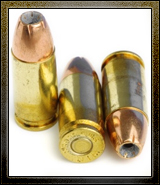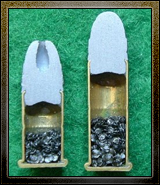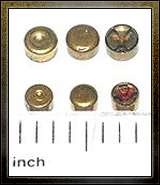 |

Introduction
Bullets are hard projectiles typically fired from a firearm (pistol, rifle, smg, etc...). They are normally made of lead, or a lead and copper mix. When a bullet is combined with a casing, primer, and gunpowder, the result is called a cartridge. The term bullet is often erroneously used to refer to the completed cartridge.
Bullets come in many different types, shapes and sizes. There are approximately 80+ bullet types, each with its own distinctive look, feel, and purpose. Here we will give you a brief overview of the different bullets, casings, and cartridge types to give the average person a better understanding of what's out there, what to look for, and what's best to use against our undead foes.
Note: The beginning part of this article is more educational than anything. It is designed to help you, the reader, understand basic concepts and terminology so we are all on the same page when we start discussing the real purpose of this article, zombie warfare!
Casings
The Casing is the biggest component of a cartridge. It houses the primer, gunpowder, and bullet, and is typically made of metal, usually brass (variations exist in aluminum, steel, and in the case of shotgun shells, brass with plastic). There are 2 major types of casings- centerfire, and the much less common rimfire.
Centerfire
|
 |
|
9mm Centerfire Cartridges
with primers and bullets
|
A centerfire casing contains a separate primer that is located directly in the center at the rear of the case opposite the bullet. The firing pin of the firearm strikes the center of the primer, which ignites the gunpowder contained inside, and the projectile (bullet) is launched. Centerfire casings are commonly made of brass due to their resistance to corrosion, and high ductility (i.e. bends rather than fractures). Centerfire casings can also be 'reloaded' several times before wearing out. (Reloading is the act of reinserting new powder, a primer, and bullet into a spent casing to create a new cartridge.) Reloading is an important skill to learn in the ammo conscious zombie future of tomorrow. Some lower quality rifle casings, as well as pistol rounds, are made of steel. Steel is much less expensive than brass and is also typically not reloadable due to the low ductility of the metal. Steel is also often used in pistol rounds as they are considered cheaper rounds, and more expendable. Although not typically done, you can reload pistol rounds.
Centerfire rounds come in several varieties, the most common being rimless; this means that the casing lacks an elevated rim near the end by the primer. Instead of a rim, a rimless casing tends to have a small groove or notch cut into the base of the case known as the extractor groove. This groove is where the shell extractor grabs onto the spent round to remove it from the breach of the gun once fired. Rimless casings are almost exclusively used on semi-automatic weapons, and most weapons that use magazines since the rounds are smooth with no protrusions, and can easily slide over each other.
The second most common form of centerfire casing is rimmed. Rimmed casings are typically used in revolvers, and breach loading weapons such as target pistols, and shotguns. They feature a small raised rim at the rear of the casing by the primer, which prevents them from sliding too far into the breach of the firearm.
There are other forms of Centerfire casings, namely, semi-rimmed, belted, and rebated rims. Belted and semi-rimmed casing perform similar to rimmed casings, while rebated rimmed casings are similar to rimless casing. Because of that, I am going to forgo explanation for simplicity sake.
Rimfire
|
 |
|
.22 Rimfire cross section
notice the lack of primer
|
Instead of the firing pin of the firearm striking a primer, like in centerfire casings, the firing pin actually strikes the outer rim of the casings, which contains the shock sensitive priming compound. For all intents and purposes, a rimfire casing is a large self-contained primer cap with gunpowder in it.
When the firing pin strikes the rim of a rimfire casing, it crushes the edge of the rim and makes a small dent in it. The pressure created is what actually ignites the primer compound and causes the bullet to fire. Because the cartridge is deformed in the process, it makes reloading impossible, making rimfire casings one time use only.
casings are only used for small caliber bullets as well. This is due to the fact that in order to fire a rimefire round, the casing needs to be dented; this requires them to be made of a much thinner brass than centerfire cases. Large caliber bullets require more gunpowder, and more gunpowder may case the thin casing to breach, or shatter while firing; posing a danger to the shooter. There are very few rimfire cartridges in use today with the most common being the .22 long and .22 long rifle.
Primers
|
 |
|
primers, both fired and
unfired
|
All primers are more or less the same. Each is a small metal cup, usually made of copper or brass, and filled with a stable, yet shock sensitive blasting compound. The primer is located at the rear of the casing opposite the bullet. When the primer is struck by the firing pin of the firearm, the blasting compound is ignited, which then ignites the gunpowder, which propels the bullet out of the casing, and down the barrel.
Gunpowder
Modern gunpowder, or smokeless powder, is not actually powder at all. It is actually made up of small granules a little larger than coarse sand grains. Modern smokeless powder is a double-base powder composed of an approximate 50/50 ratio of nitrocellulose, and nitroglycerin. Contrary to the name, smokeless powder is not entirely smokeless. It is, however, a vast improvement over its black powder ancestor, which is still used in old style muzzle loading black powder weapons today.
|
 |